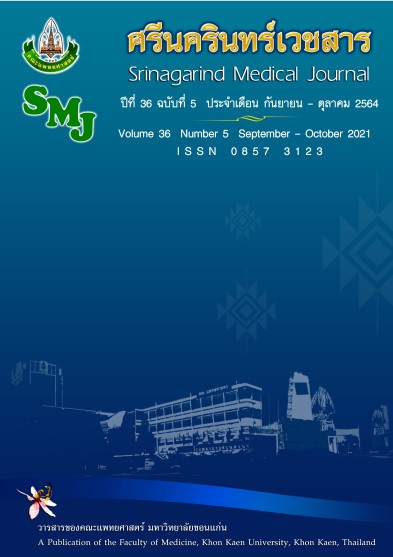ประสิทธิภาพของการให้สารน้ำแบบระยะสั้นและการให้สารน้ำแบบต่อเนื่องในการป้องกันการเกิดพิษต่อไตของยาซิสพลาติน
Abstract
Comparison of Efficacy between Short Hydration and Continuous Hydration for Prevention of Cisplatin Induced Nephrotoxicity
Kwanjit Danwilai1*, Pongpipat Samutpeth2, Saharat Pongsura2, Wittawat Jitpewngarm3, Apichai Manoi4
1Department of Pharmacy Practice, Faculty of Pharmaceutical Sciences, Naresuan University
2Faculty of Pharmaceutical sciences, Naresuan University
3Department of medicine, Faculty of Medicine, Naresuan University
4Naresuan university hospital, Faculty of Medicine, Naresuan University
Received: 13 April 2021/ Edit: 12 May 2021 / Accepted: 19 May 2021
*Corresponding author. Kwanjit Danwilai, Department of Pharmacy Practice, Faculty of Pharmaceutical Sciences, Naresuan University. Tel. 086-5897963 E-mail: kwanjit_03@hotmail.com
บทคัดย่อ
หลักการและวัตถุประสงค์: ซิสพลาติน (cisplatin) เป็นยาเคมีบำบัดที่มีข้อบ่งใช้ในการรักษามะเร็งชนิดก้อนและมะเร็งโลหิตวิทยาอย่างแพร่หลาย อาการไม่พึงประสงค์ที่สำคัญและรุนแรงได้แก่ พิษต่อไต ปัจจุบันนี้การป้องกันพิษต่อไตของยา cisplatin ที่มีประสิทธิภาพได้แก่ การให้สารน้ำอย่างเพียงพอ แต่ยังมีความหลากหลายของกลยุทธ์ดังกล่าว ดังนั้นงานวิจัยนี้ต้องการเปรียบเทียบประสิทธิภาพการให้สารน้ำแบบระยะสั้น และการให้สารน้ำแบบต่อเนื่องในการป้องกันการเกิดพิษต่อไตของยา cisplatin
วิธีการศึกษา: การวิจัยย้อนหลัง เก็บข้อมูลจากเวชระเบียนและฐานข้อมูลอิเล็กทรอนิกส์ ตั้งแต่วันที่ 1 มกราคม พ.ศ 2554 ถึง วันที่ 31 ธันวาคม พ.ศ. 2561 เกณฑ์คัดเข้า ได้แก่ ผู้ป่วยที่ได้รับการวินิจฉัยเป็นมะเร็งชนิดก้อนที่มีอายุ 20 ปีขึ้นไป และได้รับยา cisplatin ในแผนการรักษาแบบนอนในโรงพยาบาลโดยได้รับการป้องกันพิษต่อไตจาก cisplatin ด้วยสารน้ำแบบระยะสั้น (short hydration) คือการให้ 0.9%NaCl ปริมาตร 1 ลิตร ก่อนเริ่มยาเคมีบำบัดโดยอัตราเร็วการบริหารสารน้ำ ≥ 500 ml/hr หรือสารน้ำแบบต่อเนื่องคือ การให้สารน้ำ 0.9%NaCl ปริมาตร 1 ลิตร อัตราเร็วการบริหารสารน้ำ ≤ 200 ml/hr ก่อนเริ่มยาเคมีบำบัด และมี Performance status (ECOG) score 0 – 2 เกณฑ์การคัดออก ได้แก่ ข้อมูลผู้เข้าร่วมการศึกษาไม่ครบถ้วนที่จะนำมาประเมินผลการศึกษาได้ และมีค่า serum creatinine มากกว่า > 1.5 mg/dl ก่อนเริ่มยาเคมีบำบัดครั้งแรก ผลลัพธ์หลัก ได้แก่ อุบัติการณ์ของการเกิดพิษต่อไตของยา cisplatin รอบใด ๆ ≥ ความรุนแรงระดับ 3 การประเมินความรุนแรงการเกิดพิษต่อไตใช้เครื่องมือ Common Terminology Criteria for Adverse Events (CTCAE) เวอร์ชั่น 5
ผลการศึกษา: จากการทบทวนเวชระเบียนและฐานข้อมูลอิเล็กทรอนิกส์ มีผู้ป่วยที่เข้าการศึกษาทั้งหมด 81 ราย แบ่งเป็นกลุ่มที่ได้รับสารน้ำระยะสั้น 48 ราย ขนาดยา cisplatin เฉลี่ยเท่ากับ 69.33±16.03 mg/m2 และกลุ่มที่ได้รับสารน้ำแบบต่อเนื่อง 33 ราย ขนาดยา cisplatin เฉลี่ยเท่ากับ 73.39±14.72 mg/m2 ผลการวิจัยไม่พบอุบัติการณ์เกิดพิษต่อไตของยา cisplatin ความรุนแรง ≥ ระดับ 3 ที่รอบใด ๆ อุบัติการณ์เกิดพิษต่อไตของยา cisplatin ความรุนแรงทุกระดับ ที่รอบใดๆ ในกลุ่มที่ให้สารน้ำแบบระยะสั้นเปรียบเทียบกับการให้สารน้ำแบบต่อเนื่อง แตกต่างอย่างไม่มีนัยสำคัญทางสถิติ [15 ราย (ร้อยละ 31.2) เทียบกับ 16 ราย (ร้อยละ 48.5); p=0.12], เช่นเดียวกับอุบัติการณ์ของการเกิดพิษต่อไตของยา cisplatin หลังได้รับยารอบที่ 1 ความรุนแรงทุกระดับในกลุ่มที่ให้สารน้ำแบบระยะสั้นเทียบกับการให้สารน้ำแบบต่อเนื่องแตกต่างอย่างไม่มีนัยสำคัญทางสถิติ [6 ราย (ร้อยละ 12.5) เทียบกับ 4 ราย (ร้อยละ 12.1); p=0.95]
สรุป: การศึกษาย้อนหลังพบว่าการให้สารน้ำแบบระยะสั้นและการให้สารน้ำแบบต่อเนื่องในการป้องกันการเกิดพิษต่อไตของยา cisplatin มีประสิทธิภาพไม่แตกต่างกันในผู้ป่วยมะเร็งชนิดก้อน
คำสำคัญ: ประสิทธิภาพ; การให้สารน้ำแบบระยะสั้น; การให้สารน้ำแบบต่อเนื่อง; พิษต่อไต; ยาซิสพลาติน
Abstract
Background and Objective: Cisplatin is antineoplastic drug that has been used in the treatment of several type of solid tumor and hematologic malignancies. Nephrotoxicity is one of the major and most serious toxicities caused by cisplatin. Hydration is used very commonly and while effective but several strategies able to prevent nephrotoxicity. This study was to comparison efficacy of short and continuous hydration for prevention of cisplatin induced nephrotoxicity (CIN).
Methods: The retrospective study collected data from medical records and electronic databases between 1 January 2011 and 31 December 2018. Inclusion criteria was solid tumors type of patients with age ≥ 20 years old received single cisplatin or combination regimen as inpatients setting, divided into 2 groups, short hydration group (1 L 0.9%NaCl intravenous rate ≥ 500 ml/hr) and continuous hydration group (1 L 0.9%NaCl intravenous rate < 200 ml/hr) for prevention of CIN and performance status (ECOG) 0-2. No data for evaluation of efficacy and serum creatinine > 1.5 mg/dl prior treatment were excluded. Primary outcome was the incidence of CIN ≥ grade 3 after received cisplatin at any cycles. Grading of nephrotoxicity classified by common terminology criteria for adverse events (CTCAE) 5.0.
Results: A total of 81 patients were enrolled. Forty eight patients in short hydration group; median cisplatin dose was 69.33±16.03 mg/m2. Thirtythree patients in the continuous hydration group; median cisplatin dose was 73.39±14.72 mg/m2. No incidence of CIN ≥ grade 3 at any cycles reported after received cisplatin. The different of incidence of CIN at any cycles any grade between short hydration group and continuous hydration group did not reach statistical significance [15 patients (31.2%) vs 16 patients (48.5); p=0.12]. The incidence of CIN at cycle 1 any grade different between 2 groups did not reach statistical significance [6 patients (12.5%) in short hydration group and 4 patients (12.1%) in continuous hydration group; p=0.95].
Conclusion: This study showed benefit of short and continuous hydration group were similar for prevention of cisplatin induced nephrotoxicity.
Keywords: efficacy; short hydration; continuous hydration; nephrotoxicity; cisplatin


